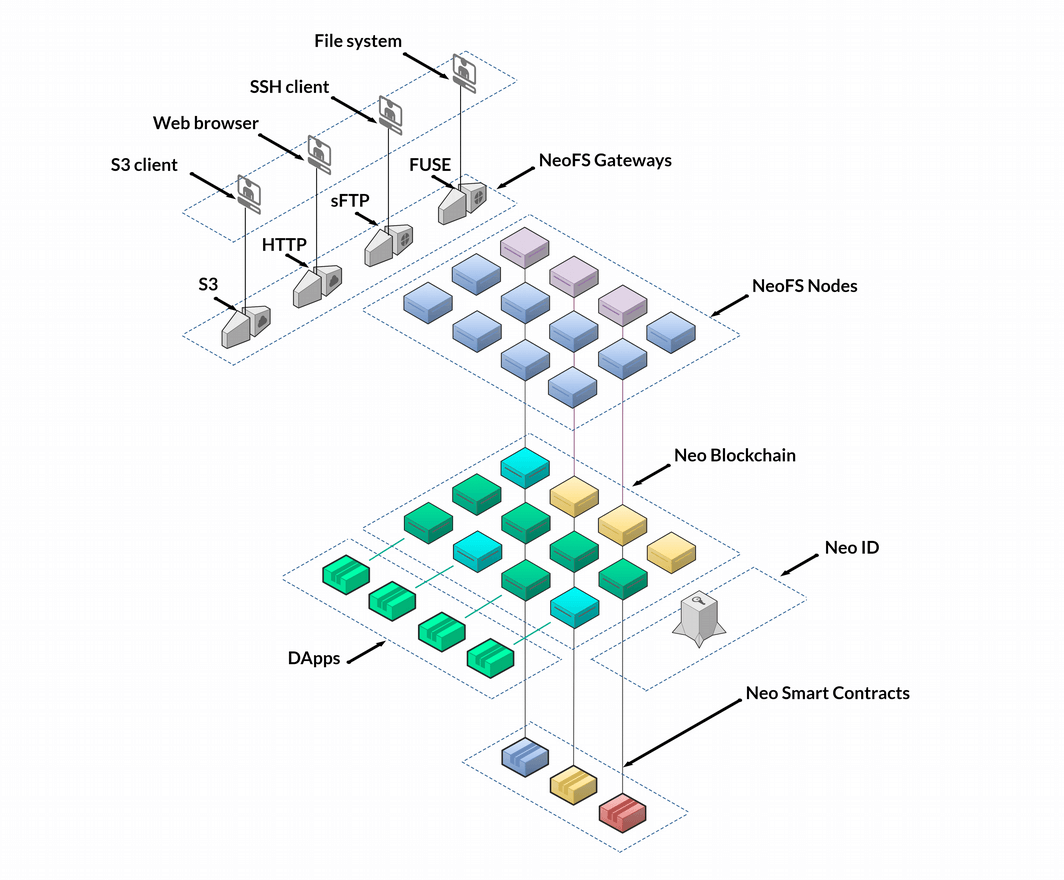NeoFS: public distributed decentralized object storage
Introduction
NeoFS is a distributed, decentralized object storage network developed by Neo SPCC. Built with Neo blockchain integration in mind, NeoFS aims to support the shift away from third-party storage providers, providing users with complete control over their data.
Nodes are organized in peer-to-peer network that takes care of storing and distributing user’s data. Any Neo user may participate in NeoFS network and get paid for providing storage resources to other users or store his data in NeoFS and pay a competitive price for it.
The service is designed to work with Neo smart contracts, allowing for truly decentralized applications, and can also be used as a content delivery network. Users can rent out storage in return for Neo GAS tokens or use GAS to store files in the network.
Representing Neo’s commitment to building the future, NeoFS offers unparalleled data storage control to users and developers by bringing together the benefits of decentralization and real-world integration.
NeoFS is geared for real-world applications
Unlike many other projects in this area, Neo SPCC is not trying to create a parallel reality in a technological sense. Solving real-world problems requires to use standard protocols and have ability to integrate NeoFS with existing systems. There are protocol adapters, or gateways, that allow accessing NeoFS via standard HTTP or S3 protocols. Users can develop their own gateways to integrate NeoFS with existing systems they are using, such as accounting system, CRM, a corporate backup service etc.
Basic components and network
NeoFS network nodes run the same software and talk the same protocol but may have different roles. There are nodes that store data and process user API requests, they are regular storage nodes and form the Outer Ring. There are nodes that take care of network health, perform service tasks such as data audit and payments settlements and form the Inner Ring. There are not many of them and they use dBFT 2.0 consensus algorithm to coordinate their actions.
Read moreKey benefits and competitive advantages
Infinitely scalable due to Network Map and Data Placement
NeoFS is infinitely horizontaly scalable due to its architecture features such as novel Data Audit algorithm, Data Placement and Network Map.
Network Map is a multi-dimensional graph where nodes have attributes and are grouped by those attributes and their values. This allows using a special data placement function to find nodes that would store an object, when putting or getting it to/from NeoFS network without any network requests.
This approach allows not having any centralized meta-data storage keeping object’s locations and not re-balancing data with every joining or leaving storage node.
Designed to work reliably in chaotic environment
The bigger the NeoFS network grows, the more stable it becomes, because the chance of network is changed would affect the particular container is decreasing with the increasing number of nodes in the network. It means, unlike in DHT approach, the amount of needed data migration decreases with the network growth.
NeoFS puts the control over data in users’ hands
Since anyone may participate in NeoFS network, reliable mechanisms to ensure users' data consistency and availability in a chaotic environment are needed.
To achieve this goal, nodes are motivated to store objects correctly by the GAS they receive for storage.
A decentralized nature of NeoFS eliminates not only centralized points of failure but also centralized points of control. In NeoFS, only users have full control over their data, where, how it is stored, and who can get access to it.
Where
your data is stored
How
your data is stored
Who
can get access to your data
Integrated with popular protocols such as HTTP and S3
NeoFS is demonstrating NEO’s commitment to practical idealism as well as its vision of an integrated, user-centric Internet of the future.
Through gateways (protocol adapters), users can easily access NeoFS through industry-standard protocols such as HTTP or S3.
Moreover, the open nature of NeoFS enables users to freely write his or her own gates to integrate with third-party system for seamless on and off-chain integration as well as unmatched accessibility.
Directly accessible from smart contract code
This feature becomes available in Neo 3.0 release with introduction of Oracles Protocol. Smart contracts will be able to issue GET and PUT requests for fixed-size objects.

Neo GAS is used for payments
NeoFS uses GAS for all payments. To be able to pay for storage services in NeoFS, the one has to deposit some GAS to NeoFS smart contract address. This event is monitored by Inner Ring nodes and reflected in user's account balance internally in NeoFS.
NeoFS Inner Ring nodes keep track of all NeoFS accounts and use dBFT 2.0 consensus algorithm, the same as in Neo blockchain, agree on users' mutual settlements, reward distribution over node owners and other payment-related procedures.
Read moreRuns on commodity hardware
NeoFS is designed to work on commodity hardware without any special hardware requirements. This allows users to quickly replace failed system components with what can be bought in a local computer store.